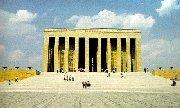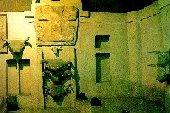ANKARA
The city of Ankara lies in the center of Anatolia
on the eastern edge of the great, high Anatolian Plateau, at an altitude
of 850 meters. It is the center of the province of the same name, which
Is a predominantly fertile wheat steppe land with forested areas in its
northeast region. It is bordered by the provinces of Cankiri and Bolu to
the north, Eskisehir to the west, Konya and Aksaray
to the south, and Kirikkale and Kirsehir to the east.
The region's history goes back to the Bronze Age, Hatti Civilization,
which was succeeded in the 2nd millennium BC by the Hittites, then the
Phrygians (10th century BC); Lydians and Persians followed. After these
came the Galatians, a Celtic race who were the first to make Ankara their
capital (3rd century BC). It was then known as Ancyra, meaning anchor.
The town subsequently fell to the Romans, Byzantines, and Selcuk's under
Alparslan in 1073, and then to the Ottomans under Yildirim Beyazit in 1402,
who remained in control until the First World War.
The town, once an important trading center on the caravan route to the
east, had declined in importance by the nineteenth century. It became an
important center again when Kemal Atatürk
chose it as the base from which to direct the War of Liberation. In consequence
of its role in the war and its strategic position, it was declared the
capital of the new Turkish Republic on the 13th October,1923.
 Anitkabir (Ataturk Mausoleum): Located
in an imposing position in the Anittepe quarter of the city stands the
Mausoleum of Kemal Ataturk, founder of the Turkish
Republic. Completed in 1953, it is an impressive fusion of ancient and
modern architectural ideas and remains unsurpassed as an accomplishment
of modern Turkish architecture. There is a museum housing writings, letters
and items belonging to Ataturk as well as an
exhibition of photographs recording important moments in his life and the
establishment of the republic. (Anitkabir and the museum is open everyday,
except Mondays. During the summer, there is a light and sound show in the
evenings).
Anitkabir (Ataturk Mausoleum): Located
in an imposing position in the Anittepe quarter of the city stands the
Mausoleum of Kemal Ataturk, founder of the Turkish
Republic. Completed in 1953, it is an impressive fusion of ancient and
modern architectural ideas and remains unsurpassed as an accomplishment
of modern Turkish architecture. There is a museum housing writings, letters
and items belonging to Ataturk as well as an
exhibition of photographs recording important moments in his life and the
establishment of the republic. (Anitkabir and the museum is open everyday,
except Mondays. During the summer, there is a light and sound show in the
evenings).
 The Museum of Anatolian Civilizations : Close to the citadel
gate an old bedesten has been beautifully restored and now houses a marvelous
and unique collection including Paleolithic, Neolithic, Hatti, Hittite,
Phrygian, Urartian and Roman works. (Open everyday, except Monday. During
the summer, the museum opens everyday).
The Museum of Anatolian Civilizations : Close to the citadel
gate an old bedesten has been beautifully restored and now houses a marvelous
and unique collection including Paleolithic, Neolithic, Hatti, Hittite,
Phrygian, Urartian and Roman works. (Open everyday, except Monday. During
the summer, the museum opens everyday).
The Ethnographical Museum : Opposite the Opera House on Talat
Pasa Boulevard is the Ethnographical Museum. There is a fine collection
of folkloric artifacts as well as fine items from Seljuk and Ottoman mosques.
(Open everyday, except Monday).
The Ankara Citadel : The foundations of the citadel were laid
by the Galatians on a prominent lava outcrop, and completed by the Romans;
the Byzantines and Seljuk's made restorations and additions. The area around
and inside the citadel is the oldest part of Ankara and many fine examples
of traditional architecture can be seen within the citadel walls. There
are also lovely green areas in which to relax.
The Temple of Augustus : The temple can be found in the Ulus
quarter of the city. It was built in the 2nd century BC and only later
dedicated to the Emperor Augustus. It is important today for the 'Monument
Ancyranum', the testament of Augustus that is inscribed on its walls in
Latin and Greek. In the fifth century the temple was converted to a church.
The Roman Bath : The bath, situated on Cankiri Avenue in Ulus,
has the typical features of Roman baths: a frigidarium (cold section),
tepidarium (cool section) and caldarium (hot section). They were built
in the time of the Emperor Caracalla (3rd century AD) in honor of the
god of medicine, Asclepios. Today only the basement and first floors remain.
The Column of Julian : This column, in Ulus, was erected in 362
AD probably to commemorate a visit by the Roman Emperor Julian the Apostate.
It stands fifteen meters high and has a typical leaf decoration on the
capital.
Haci Bayram Mosque : This mosque, in Ulus, next to the Temple
of Augustus, was built in the early 15th century and subsequently restored
by Sinan in the l6th century with Kütahya tiles being added in the
18th century. The mosque was built in honor of Haci Bayram Veli whose
tomb is next to the mosque.
Go back to the Homepage
 Anitkabir (Ataturk Mausoleum): Located
in an imposing position in the Anittepe quarter of the city stands the
Mausoleum of Kemal Ataturk, founder of the Turkish
Republic. Completed in 1953, it is an impressive fusion of ancient and
modern architectural ideas and remains unsurpassed as an accomplishment
of modern Turkish architecture. There is a museum housing writings, letters
and items belonging to Ataturk as well as an
exhibition of photographs recording important moments in his life and the
establishment of the republic. (Anitkabir and the museum is open everyday,
except Mondays. During the summer, there is a light and sound show in the
evenings).
Anitkabir (Ataturk Mausoleum): Located
in an imposing position in the Anittepe quarter of the city stands the
Mausoleum of Kemal Ataturk, founder of the Turkish
Republic. Completed in 1953, it is an impressive fusion of ancient and
modern architectural ideas and remains unsurpassed as an accomplishment
of modern Turkish architecture. There is a museum housing writings, letters
and items belonging to Ataturk as well as an
exhibition of photographs recording important moments in his life and the
establishment of the republic. (Anitkabir and the museum is open everyday,
except Mondays. During the summer, there is a light and sound show in the
evenings).
 The Museum of Anatolian Civilizations : Close to the citadel
gate an old bedesten has been beautifully restored and now houses a marvelous
and unique collection including Paleolithic, Neolithic, Hatti, Hittite,
Phrygian, Urartian and Roman works. (Open everyday, except Monday. During
the summer, the museum opens everyday).
The Museum of Anatolian Civilizations : Close to the citadel
gate an old bedesten has been beautifully restored and now houses a marvelous
and unique collection including Paleolithic, Neolithic, Hatti, Hittite,
Phrygian, Urartian and Roman works. (Open everyday, except Monday. During
the summer, the museum opens everyday).